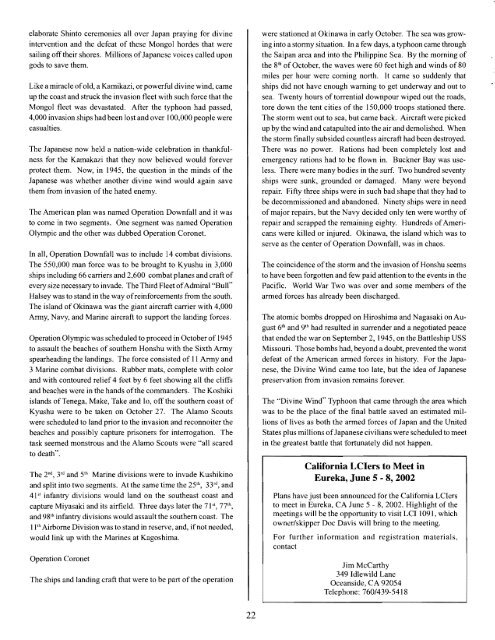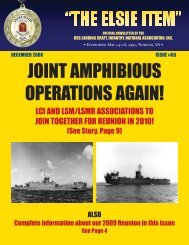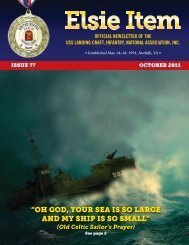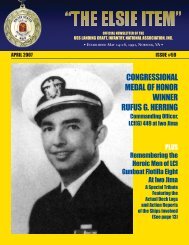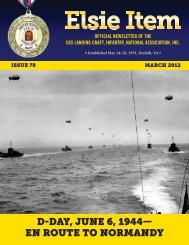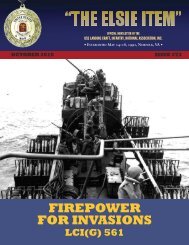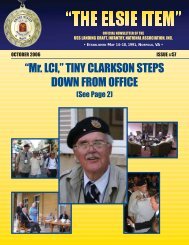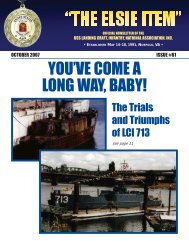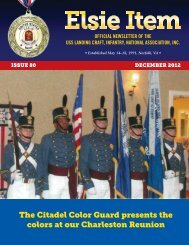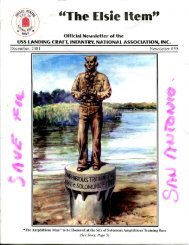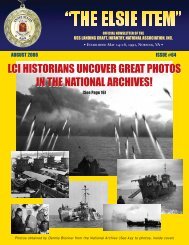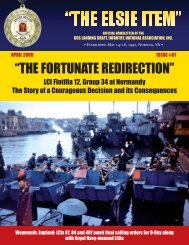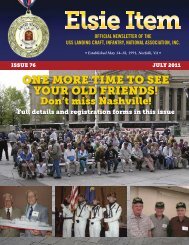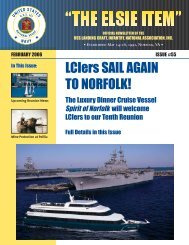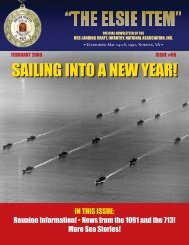"The Elsie Item" - USS Landing Craft Infantry National Association
"The Elsie Item" - USS Landing Craft Infantry National Association
"The Elsie Item" - USS Landing Craft Infantry National Association
You also want an ePaper? Increase the reach of your titles
YUMPU automatically turns print PDFs into web optimized ePapers that Google loves.
elaborate Shinto ceremonies all over Japan praying for divineintervention and the defeat of these Mongol hordes that weresailing offtheir shores. Millions ofJapanese voices called upongods to save them.Like a miracle ofold, a Kamikazi, or powerful divine wind, cameup the coast and struck the invasion fleet with such force that theMongol fleet was devastated. After the typhoon had passed,4,000 invasion ships had been lost and over 100,000 people werecasualties.<strong>The</strong> Japanese now held a nation-wide celebration in thankfulnessfor the Kamakazi that they now believed would foreverprotect them. Now, in 1945, the question in the minds of theJapanese was whether another divine wind would again savethem from invasion of the hated enemy.<strong>The</strong> American plan was named Operation Downfall and it wasto come in two segments. One segment was named OperationOlympic and the other was dubbed Operation Coronet.In all, Operation Downfall was to include 14 combat divisions.<strong>The</strong> 550,000 man force was to be brought to Kyushu in 3,000ships including 66 carriers and 2,600 combat planes and craft ofevery size necessary to invade. <strong>The</strong> Third Fleet ofAdmiral "Bull"Halsey was to stand in the way ofreinforcements from the south.<strong>The</strong> island of Okinawa was the giant aircraft carrier with 4,000Army, Navy, and Marine aircraft to support the landing forces.Operation Olympic was scheduled to proceed in October of 1945to assault the beaches of southern Honshu with the Sixth Armyspearheading the landings. <strong>The</strong> force consisted of II Army and3 Marine combat divisions. Rubber mats, complete with colorand with contoured relief 4 feet by 6 feet showing all the cliffsand beaches were in the hands ofthe commanders. <strong>The</strong> Koshikiislands ofTen ega, Make, Take and 10, off the southern coast ofKyushu were to be taken on October 27. <strong>The</strong> Alamo Scoutswere scheduled to land prior to the invasion and reconnoiter thebeaches and possibly capture prisoners for interrogation. <strong>The</strong>task seemed monstrous and the Alamo Scouts were "all scaredto death".<strong>The</strong> 2 nd , 3 rd and 5 th Marine divisions were to invade Kushikinoand split into two segments. At the same time the 25'\ 33 rd , and41 st infantry divisions would land on the southeast coast andcapture Miyasaki and its airfield. Three days later the 71 st, 77'11,and 98'h infantry divisions would assault the southern coast. <strong>The</strong>11 th Airborne Division was to stand in reserve, and, ifnot needed,would link up with the Marines at Kagoshima.Operation Coronet<strong>The</strong> ships and landing craft that were to be part ofthe operationwere stationed at Okinawa in early October. <strong>The</strong> sea was growinginto a stormy situation. In a few days, a typhoon came throughthe Saipan area and into the Philippine Sea. By the morning ofthe 8 th of October, the waves were 60 feet high and winds of 80miles per hour were coming north. It came so suddenly thatships did not have enough warning to get underway and out tosea. Twenty hours of torrential downpour wiped out the roads,tore down the tent cities of the 150,000 troops stationed there.<strong>The</strong> storm went out to sea, but came back. Aircraft were pickedup by the wind and catapulted into the air and demolished. Whenthe storm finally subsided countless aircraft had been destroyed.<strong>The</strong>re was no power. Rations had been completely lost andemergency rations had to be flown in. Buckner Bay was useless.<strong>The</strong>re were many bodies in the surf. Two hundred seventyships were sunk, grounded or damaged. Many were beyondrepair. Fifty three ships were in such bad shape that they had tobe decommissioned and abandoned. Ninety ships were in needof major repairs, but the Navy decided only ten were worthy ofrepair and scrapped the remaining eighty. Hundreds ofAmericanswere killed or injured. Okinawa, the island which was toserve as the center of Operation Downfall, was in chaos.<strong>The</strong> coincidence ofthe storm and the invasion ofHonshu seemsto have been forgotten and few paid attention to the events in thePacific. World War Two was over and some members of thearmed forces has already been discharged.<strong>The</strong> atomic bombs dropped on Hiroshima and Nagasaki on August6 th and 9 th had resulted in surrender and a negotiated peacethat ended the war on September 2, 1945, on the Battleship <strong>USS</strong>Missouri. Those bombs had, beyond a doubt, prevented the worstdefeat of the American armed forces in history. For the Japanese,the Divine Wind came too late, but the idea of Japanesepreservation from invasion remains forever.<strong>The</strong> "Divine Wind" Typhoon that came through the area whichwas to be the place of the final battle saved an estimated millionsof lives as both the anned forces of Japan and the UnitedStates plus millions ofJapanese civilians were scheduled to meetin the greatest battle that fortunately did not happen.California LCIers to Meet in Eureka, June 5 - 8, 2002 Plans have just been announced for the California LClersto meet in Eureka, CA June 5 - 8,2002. Highlight of themeetings will be the opportunity to visit LCI 1091, whichowner/skipper Doc Davis will bring to the meeting.For further information and registration materials,contactJim McCarthy 349 Idlewild Lane Oceanside, CA 92054 Telephone: 760/439-5418 22


